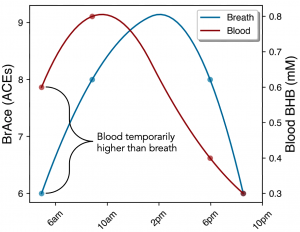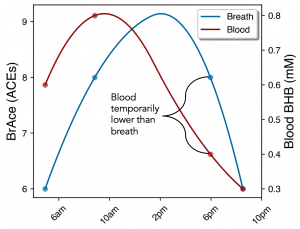TL;DR: your blood and breath readings may not match because of time lags between blood and breath ketones, or because your body has become “keto-adapted”.
Let’s say you’ve recently started using BIOSENSE but aren’t quite ready to give up your blood ketone meter. It’s natural to want to compare readings between the two devices. While experimenting, you will probably notice that the majority of the time, the two devices show very similar results (e.g. if you see a 0.5 reading on your blood meter, you’ll see about 5 ACEs on your BIOSENSE). But other times, the two readings may deviate.
There is one fact above all others to keep in mind when comparing readings from your two devices: blood ketones and breath ketones are different molecules. Blood meters measure beta-hydroxybutyrate (BHB), while BIOSENSE measures acetone in the breath. While both molecules are ketone bodies and are often strongly correlated, there are some important differences between them. In this post, we’ll cover some of the common patterns you may see when comparing blood and breath readings, and the biology behind those patterns.
Case 1: Blood is higher than breath
During the BIOSENSE clinical trial, participants simultaneously measured their blood and breath ketones 5 times per day for 2 weeks. This data allowed us to better understand how blood and breath ketones are related.
One of the most important things we observed is that sometimes changes in blood and breath ketones are offset in time. The graph below shows one day of ketone data for one trial participant. In this case, blood ketones changed before breath ketones did. If this participant were to compare their blood and breath meters before 10am, she would notice that blood is higher than breath. This is because changes in her breath readings lagged behind her blood readings by a few hours. If you’re observing blood readings that are higher than your breath readings, it may be that your breath ketones have simply not caught up with your blood ketones.

Case 2: Blood is lower than breath
Other times you may notice that your blood readings are lower than your breath readings. There are a few different reasons why this might happen.
Returning to our trial participant’s graph, once blood ketones peak and begin falling, they switch from being higher than breath to being lower than breath. This is once again because of the delay between changes in blood and breath.

While the above example shows blood changing before breath, there are other instances where breath can change before blood. This occurs most notably after strenuous exercise. In this situation, you may observe the opposite effect to what we discussed above.
Whether blood leads or lags behind breath, our clinical trial data showed that the total daily ketone “dose,” or the amount of ketones your body “sees” during the day, is the same whether you use a blood or a BIOSENSE breath meter. This means that while there are time lags that may cause discrepancies in the point-by-point comparison of blood and breath, overall they are equally valid indicators of your body’s fat burn rate.
Other than time lags, which cause temporary blood/breath discrepancies, there are situations where blood may be permanently lower than breath. This situation applies to many long-term keto dieters and fasters. There have been many anecdotal reports from these so-called “keto-adapted” individuals that their blood BHB drops with time. Although there haven’t been any good clinical studies on this, we can hypothesize why this might be.
The body can convert one ketone body into another depending on the energy supply and demand balance in the body. Long-term keto dieters and fasters have learned to use ketones more efficiently than someone who is just starting out. For these keto-adapted individuals, their energy supply and demand are more balanced, and their bodies do not need to convert the other ketones into BHB as often. The result of this is that the ratio of acetone to BHB in the body increases. This biological phenomenon can produce a 20x or greater ratio in our ACEs measurement compared to the blood ketone equivalent.The benefit of measuring acetone is that it more directly indicates the amount of ketones that your body is actually using (since it is a direct proxy for acetoacetate, the energy-supplying ketone). This has led experts like Dom D’Agostino to speculate that BIOSENSE breath acetone measurements may actually be a better indicator of fasting ketosis than blood BHB.



